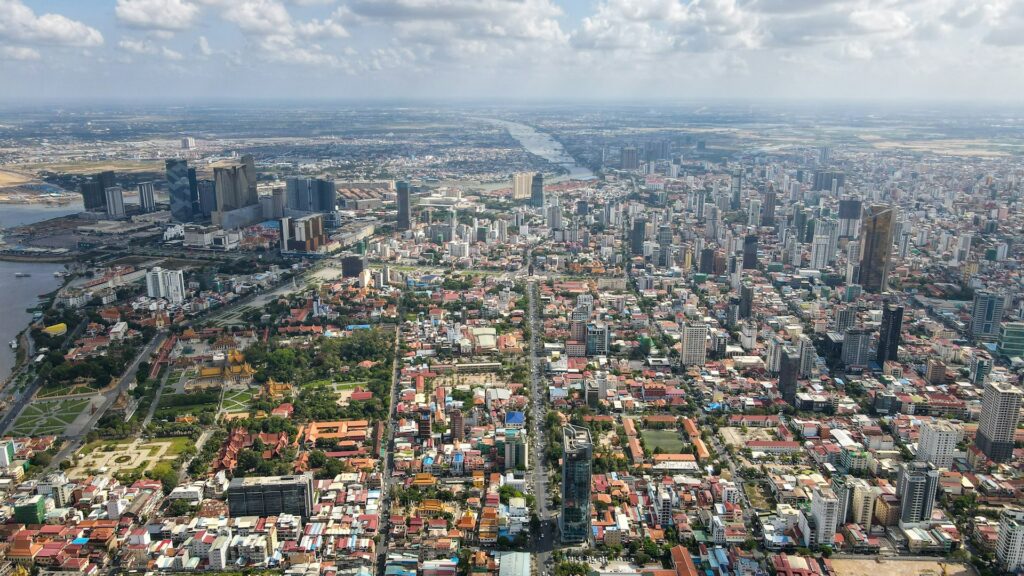
Cambodia’s two most famous cities: Phnom Penh and Siem Reap both offer unique experiences for travelers, blending ancient traditions with modern attractions. In this article, we’ll compare Phnom Penh and Siem Reap, highlighting what makes each city special, their differences, and why you should visit both.
Historical Significance
Phnom Penh:
As the capital city of Cambodia, Phnom Penh is steeped in history and has been a center of power, culture, and economic activity for centuries. It was once known as the “Pearl of Asia” during French colonial times. Key historical sites include:
- The Royal Palace: This grand complex, home to the King of Cambodia, is a stunning example of Khmer architecture. Visitors can explore the Silver Pagoda, which houses many national treasures.
- Tuol Sleng Genocide Museum: A stark reminder of Cambodia’s dark past under the Khmer Rouge regime, this museum is located in a former high school turned prison and interrogation center.
- Choeung Ek Genocidal Center (Killing Fields): Located outside the city, this site is a somber but essential visit to understand the extent of the atrocities committed during the Khmer Rouge era.
Siem Reap:
Siem Reap is the gateway to the ancient temples of Angkor, making it a focal point for Cambodia’s ancient history.
- Angkor Wat: The largest religious monument in the world, Angkor Wat is a UNESCO World Heritage Site and a symbol of Cambodia. The temple complex dates back to the 12th century and is renowned for its stunning architecture and intricate carvings.
- Angkor Thom and Bayon Temple: Known for the enigmatic faces carved into its towers, Bayon Temple is another highlight within the Angkor complex.
- Ta Prohm: Famously featured in the movie “Tomb Raider,” this temple is known for the massive tree roots that have overtaken the stone structures, creating a unique and picturesque scene.
Cultural Experiences
Phnom Penh:
- Phsar Thmey (Central Market): This Art Deco market is a great place to experience local life, shop for souvenirs, and sample Cambodian street food.
- Nightlife and Dining: Phnom Penh boasts a vibrant nightlife with numerous bars, restaurants, and cafes. The Riverside area, in particular, is known for its lively atmosphere and variety of dining options.
- Art and Museums: The National Museum of Cambodia houses an impressive collection of Khmer art and artifacts, while the city’s growing art scene includes contemporary galleries and exhibitions.
Siem Reap:
- Old Market (Psar Chas): A bustling market where you can buy local crafts, textiles, and fresh produce. It’s also a great spot to try local dishes.
- Pub Street: Known for its nightlife, Pub Street is packed with bars, restaurants, and nightclubs, making it the heart of Siem Reap’s entertainment scene.
- Cultural Shows: Siem Reap offers a variety of traditional dance performances, such as the Apsara Dance, and traditional shadow puppetry which provide insight into Cambodia’s rich cultural heritage.
Natural Beauty and Outdoor Activities
Phnom Penh:
- Mekong River: Take a sunset cruise along the Mekong River for stunning views of the city and a relaxing escape from the hustle and bustle.
- Koh Dach (Silk Island): A short ferry ride from Phnom Penh, this island is known for its traditional silk weaving villages and scenic rural landscapes.
Siem Reap:
- Tonle Sap Lake: The largest freshwater lake in Southeast Asia, Tonle Sap is home to floating villages and diverse wildlife. Boat tours offer a glimpse into the lives of the lake’s inhabitants.
- Phnom Kulen National Park: A sacred mountain with beautiful waterfalls, ancient temples, and stunning viewpoints, perfect for a day trip from Siem Reap.
Key Differences
Atmosphere:
- Phnom Penh: As the bustling capital city, Phnom Penh is vibrant, fast-paced, and constantly evolving. Its streets are busy with traffic, markets, and a mix of modern and colonial architecture. The city’s energy is palpable, offering a dynamic urban experience.
- Siem Reap: In contrast, Siem Reap has a more relaxed and tourist-oriented vibe. The city serves as a gateway to the Angkor temples and caters heavily to visitors, with numerous boutique hotels, restaurants, and cultural performances. Its pace is slower, making it an ideal spot for leisurely exploration.
Economic Activity:
- Phnom Penh: Being the political and economic hub of Cambodia, Phnom Penh hosts the country’s government offices, embassies, and major businesses. The city is a center for commerce and trade, contributing significantly to Cambodia’s economy.
- Siem Reap: Siem Reap’s economy is largely driven by tourism, with the Angkor Archaeological Park being the primary attraction. The local economy benefits from hospitality, retail, and cultural tourism activities.
Travel
To make your travel between these two incredible cities simple and enjoyable, book your transportation through Camboticket.com where you can securely book your overland transportation including buses, ferries, and private taxis. The journey is only about 5 hours by road.
Both Phnom Penh and Siem Reap offer unique and enriching experiences that showcase different aspects of Cambodia’s history, culture, and natural beauty. Phnom Penh, with its historical significance and vibrant urban life, contrasts beautifully with Siem Reap’s ancient temples and serene landscapes. Visiting both cities provides a comprehensive insight into the heart and soul of Cambodia.